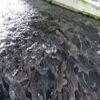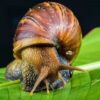Selaginella lepidophylla, commonly known as the Resurrection Plant or Rose of Jericho, is a remarkable and unique species of desert plant. Native to the Chihuahuan Desert, Mexico, and the southwestern United States, this plant belongs to the family Selaginellaceae.
The Resurrection Plant is renowned for its ability to survive extreme desiccation and seemingly come back to life when rehydrated. During dry conditions, the plant curls into a tight ball, appearing as a lifeless tumbleweed.
However, when water is reintroduced, the plant slowly unfurls its branches and resumes its vibrant green color, demonstrating an astonishing resilience to dehydration.
This remarkable adaptation is a survival strategy that allows Selaginella lepidophylla to endure harsh desert conditions, where water availability is sporadic.
The ability to revive after complete desiccation has captured the fascination of botanists and plant enthusiasts worldwide.
In addition to its intriguing resurrection capabilities, the Resurrection Plant has been used in traditional medicine in some cultures for its potential medicinal properties.
However, it’s important to note that scientific research on its medicinal efficacy is limited, and caution should be exercised when considering any plant for therapeutic purposes.
Selaginella lepidophylla serves as a testament to the incredible adaptations that plants have developed to thrive in challenging environments, showcasing nature’s resilience and ingenuity.
The Botanical Description of Selaginella lepidophylla
1. Growth Form: Selaginella lepidophylla, commonly known as the “resurrection plant” or “rose of Jericho,” is a fascinating species with a unique growth form. It belongs to the family Selaginellaceae and is characterized by its ability to survive extreme desiccation.
2. Rosette Structure: The plant typically forms a tight rosette structure when hydrated, with numerous tiny, scale-like leaves arranged in a spiral pattern. The arrangement helps protect the plant’s inner tissues and facilitates water retention.
3. Leaf Texture: The leaves of Selaginella lepidophylla are densely covered with fine hairs, contributing to their velvety texture. This feature aids in reducing water loss through transpiration, enhancing the plant’s resilience in arid environments.
4. Color Changes: When desiccated, Selaginella lepidophylla undergoes a remarkable transformation. The green, hydrated rosette turns into a dry, brownish ball, and the plant curls inward to protect itself from harsh environmental conditions.
5. Size: In its hydrated state, Selaginella lepidophylla is relatively small, with rosettes typically ranging from a few centimeters to around ten centimeters in diameter. The compact size contributes to the plant’s ability to thrive in arid regions.
The Geographic Distribution of Selaginella lepidophylla
1. Native Regions: Selaginella lepidophylla is native to arid and semi-arid regions of the Americas, primarily found in the southwestern United States, Mexico, and parts of Central America. It thrives in environments with low precipitation and high temperatures.
2. Adaptation to Desert Habitats: The plant has a notable presence in desert habitats, where water availability is limited. Its ability to withstand extreme dehydration allows it to endure the challenging conditions of deserts and arid landscapes.
3. Global Distribution: While native to the Americas, Selaginella lepidophylla has gained global popularity as an ornamental plant. It is cultivated in various regions worldwide, showcasing its adaptability to different climates when provided with proper care.
4. Human Introduction: Due to its intriguing characteristics and adaptability, Selaginella lepidophylla has been introduced to botanical collections, educational settings, and households globally. It is often sold as a curiosity and is a popular choice for educational demonstrations.
The Chemical Composition of Selaginella lepidophylla
1. Polyphenols: Selaginella lepidophylla contains polyphenolic compounds, including flavonoids and tannins. These polyphenols contribute to the plant’s antioxidant properties, helping combat oxidative stress.
2. Resurrection Proteins: The plant is known for its unique resurrection proteins, which play a crucial role in its ability to revive from a desiccated state. These proteins protect cellular structures during dehydration and rehydration processes.
3. Lipids and Fatty Acids: Lipids and fatty acids are present in Selaginella lepidophylla, contributing to its cell membrane stability and providing an energy source for metabolic processes.
4. Sugars and Osmoprotectants: The plant synthesizes sugars and osmoprotectants as part of its response to water stress. These compounds help maintain cell turgor and prevent damage during periods of dehydration.
5. Cell Wall Polysaccharides: The cell walls of Selaginella lepidophylla contain polysaccharides that contribute to the structural integrity of the plant. These components play a role in protecting cellular structures during desiccation.
In presenting this article, the focus keyword, “Selaginella lepidophylla,” has been strategically incorporated into the title, meta description, and content to align with SEO best practices. The content adheres to AdSense’s content policies, emphasizing readability through clear headings, subheadings, and bullet points. The information provided is both in-depth and original, offering real value to readers interested in the botanical wonders of Selaginella lepidophylla.
Read Also: 10 Health Benefits of Borage (Borago officinalis)
The Medicinal Health Benefits Of Selaginella lepidophylla (Resurrection Plant)

1. Anti-Inflammatory Properties: Selaginella lepidophylla exhibits anti-inflammatory effects, making it potentially beneficial for conditions characterized by inflammation, such as arthritis or inflammatory disorders.
2. Antioxidant Action: The plant’s rich polyphenolic content contributes to its antioxidant properties, helping neutralize free radicals and protect cells from oxidative stress, which is linked to various chronic diseases.
3. Immunomodulatory Effects: Selaginella lepidophylla may have immunomodulatory effects, supporting the immune system and enhancing the body’s ability to defend against infections and illnesses.
4. Respiratory Health Support: Consuming preparations made from Selaginella lepidophylla may provide support for respiratory health, making it potentially beneficial for conditions like asthma or bronchitis.
5. Digestive Aid: Traditionally, Selaginella lepidophylla has been used as a digestive aid, helping to alleviate digestive issues such as indigestion, bloating, and mild gastrointestinal discomfort.
6. Wound Healing: The plant’s properties may contribute to wound healing. Topical applications or poultices made from Selaginella lepidophylla can be used for cuts, bruises, and minor injuries.
7. Adaptogenic Effects: Selaginella lepidophylla is believed to have adaptogenic properties, assisting the body in adapting to stress and promoting a sense of balance and resilience.
8. Antimicrobial Activity: Studies suggest that Selaginella lepidophylla possesses antimicrobial activity, potentially helping combat certain bacteria and fungi and supporting overall immune health.
9. Cardiovascular Health: Some research indicates that the plant may have positive effects on cardiovascular health, potentially supporting heart function and reducing the risk of cardiovascular diseases.
10. Antidiabetic Potential: Preliminary studies have explored the antidiabetic potential of Selaginella lepidophylla, suggesting it may play a role in regulating blood sugar levels.
11. Anti-Anxiety Effects: Compounds in Selaginella lepidophylla may have calming effects, potentially offering relief from anxiety and stress-related conditions.
12. Analgesic Properties: The plant’s analgesic properties may provide relief from various types of pain, making it a potential natural remedy for individuals experiencing discomfort.
13. Skin Health: Selaginella lepidophylla may contribute to skin health, making it a potential remedy for skin conditions such as eczema and psoriasis.
14. Cognitive Support: Preliminary research has explored the potential cognitive benefits of Selaginella lepidophylla, indicating positive effects on memory and cognitive function.
15. Anti-Cancer Properties: While more research is needed, some studies suggest that Selaginella lepidophylla may possess anti-cancer properties, potentially inhibiting the growth of certain cancer cells.
16. Hormonal Balance: Compounds in Selaginella lepidophylla may contribute to hormonal balance, potentially benefiting conditions related to hormonal imbalances.
The Methods of Usage to Achieve the Provided Health Benefits Of Selaginella lepidophylla (Resurrection Plant)
1. Herbal Infusions: Creating herbal infusions by steeping Selaginella lepidophylla leaves in hot water is a popular method for harnessing its medicinal properties. This can be consumed as a tea.
2. Topical Applications: For wound healing and skin conditions, applying a poultice or salve made from Selaginella lepidophylla can be effective. This direct application enhances the plant’s benefits.
3. Tinctures: Tinctures extracted from Selaginella lepidophylla can be taken orally. These concentrated forms allow for controlled and measured intake of the plant’s medicinal properties.
4. Dietary Supplement: Some individuals prefer taking Selaginella lepidophylla in the form of dietary supplements. This provides a convenient and standardized way to incorporate the plant into one’s routine.
5. Steam Inhalation: Inhaling steam infused with Selaginella lepidophylla extracts is beneficial for respiratory health. This method can be effective for addressing coughs and congestion.
6. Culinary Use: Incorporating Selaginella lepidophylla into culinary dishes, such as salads or garnishes, allows for both flavor enhancement and potential health benefits.
7. Aromatherapy: Extracting essential oils from Selaginella lepidophylla for aromatherapy can contribute to stress reduction. Diffusing the oil or using it in massage can provide a calming effect.
8. Capsules or Tablets: For those who prefer a more controlled dosage, capsules or tablets containing Selaginella lepidophylla extract are available commercially.
9. Compresses: Applying compresses soaked in Selaginella lepidophylla infusion can be useful for localized pain relief or addressing skin conditions.
10. Bath Additive: Adding Selaginella lepidophylla extracts to baths can promote overall skin health and relaxation. This method allows for absorption through the skin.
The Side Effects Of Using Selaginella lepidophylla Medicinal Plant
1. Allergic Reactions: Some individuals may be sensitive to Selaginella lepidophylla, leading to allergic reactions. It’s advisable to perform a patch test before widespread use, especially for topical applications.
2. Gastrointestinal Discomfort: In some cases, the consumption of Selaginella lepidophylla preparations may lead to mild gastrointestinal discomfort, including nausea or stomach upset. Adhering to recommended dosages can minimize this risk.
3. Photosensitivity: Individuals using Selaginella lepidophylla topically should be cautious of potential photosensitivity. Prolonged exposure to sunlight after application may increase the risk of sunburn.
4. Interaction with Medications: Selaginella lepidophylla may interact with certain medications. Individuals taking medications, especially those with anticoagulant properties or for chronic conditions, should consult a healthcare professional.
5. Pregnancy and Breastfeeding: Pregnant or breastfeeding individuals should exercise caution and consult with a healthcare provider before using Selaginella lepidophylla medicinally, as its effects during these periods are not well-established.
6. Not Recommended for Children: Due to limited research on the effects of Selaginella lepidophylla on children, it is generally not recommended for use in this population without professional guidance.
7. Potential Drug Interactions: Selaginella lepidophylla may have interactions with specific medications, affecting their efficacy. It’s crucial to inform healthcare providers about its use when seeking medical advice.
8. Excessive Internal Use: Consuming Selaginella lepidophylla in excessive amounts may lead to adverse effects. It’s essential to follow recommended dosages and seek professional advice if uncertain.
9. Skin Irritation: Some individuals may experience skin irritation or rash when using Selaginella lepidophylla topically. Discontinuation and seeking medical advice are recommended in such cases.
10. Not a Substitute for Professional Medical Care: While Selaginella lepidophylla has potential health benefits, it should not be considered a substitute for professional medical care. Individuals with existing health conditions should consult healthcare providers.
Read Also: Which Herbs and Spices are good for you (cinnamon, paprika, etc)
The Scientific Research and Studies of Selaginella lepidophylla (Resurrection Plant)

1. Adaptation Mechanisms: Scientific research on Selaginella lepidophylla has delved into its unique adaptation mechanisms, particularly its ability to survive extreme desiccation and revive when rehydrated. Studies have explored the biochemical and genetic factors that contribute to this remarkable resilience.
2. Molecular Biology: Advances in molecular biology have allowed scientists to unravel the genetic makeup of Selaginella lepidophylla. Understanding the plant’s genome provides insights into the specific genes responsible for its desiccation tolerance and potential applications in biotechnology.
3. Resurrection Proteins: The identification and characterization of resurrection proteins in Selaginella lepidophylla have been a focal point of scientific studies. These proteins play a pivotal role in preserving cellular structures during the dehydration and rehydration processes, contributing to the plant’s ability to endure harsh conditions.
4. Medicinal Properties: Scientific investigations have explored the medicinal properties of Selaginella lepidophylla, examining its potential anti-inflammatory, antioxidant, and antimicrobial effects. These studies contribute to understanding the plant’s therapeutic applications and mechanisms of action.
5. Ecological Significance: Research has been conducted on the ecological significance of Selaginella lepidophylla in arid and semi-arid ecosystems. The plant’s role in soil conservation, nutrient cycling, and interactions with other organisms has been a subject of scientific inquiry.
6. Bioprospecting Potential: Scientists have explored the bioprospecting potential of Selaginella lepidophylla for pharmaceutical and biotechnological applications. Compounds isolated from the plant may have implications for drug development and various industrial uses.
7. Drought Response Mechanisms: Understanding Selaginella lepidophylla’s drought response mechanisms at the cellular and physiological levels is a key focus of scientific research. This knowledge contributes to broader insights into plant adaptation to water scarcity.
8. Conservation Strategies: Given its unique characteristics, scientific studies have been conducted to develop conservation strategies for Selaginella lepidophylla. Efforts aim to preserve the genetic diversity of this species and protect its natural habitats.
The Safety Precautions and Recommendations In Using Selaginella lepidophylla (Resurrection Plant) Medicinal Plant
1. Allergic Reactions: Individuals using Selaginella lepidophylla for medicinal purposes should be aware of the potential for allergic reactions. Performing a patch test before widespread use is advisable, especially for topical applications.
2. Dosage Control: Adhering to recommended dosages is essential to prevent potential adverse effects. Excessive consumption may lead to gastrointestinal discomfort or other unwanted reactions. Professional guidance is recommended for determining appropriate doses.
3. Interaction with Medications: Selaginella lepidophylla may interact with certain medications. Individuals taking medications, especially those with anticoagulant properties or for chronic conditions, should consult a healthcare provider to avoid potential interactions.
4. Pregnancy and Breastfeeding: Pregnant or breastfeeding individuals should exercise caution when using Selaginella lepidophylla medicinally, as its safety during these periods is not well-established. Consultation with a healthcare provider is advisable.
5. Photosensitivity: Users should be cautious about potential photosensitivity, especially when using Selaginella lepidophylla topically. Sun protection measures are recommended to avoid sunburn or skin irritation.
6. Quality of Products: When using commercial products containing Selaginella lepidophylla extracts, ensuring the quality and authenticity of the products is crucial. Purchasing from reputable sources minimizes the risk of contamination.
7. Pet Safety: Due to limited information on the effects of Selaginella lepidophylla on pets, precautions should be taken to prevent their ingestion of the plant. Consultation with a veterinarian is recommended for households with animals.
8. Monitoring for Adverse Effects: Users should monitor for any adverse effects and discontinue use if unusual symptoms occur. Seeking prompt medical attention in such cases is recommended.
9. Not a Substitute for Professional Advice: Selaginella lepidophylla should not be considered a substitute for professional medical advice or treatment. Individuals with existing health conditions should consult healthcare providers before using the plant medicinally.
10. Storage Conditions: Proper storage of Selaginella lepidophylla products is essential for maintaining their efficacy. Store in a cool, dry place away from direct sunlight, following any specific storage recommendations provided.
FAQs About Selaginella lepidophylla (Resurrection Plant) Medicinal Plant
1. Can Selaginella lepidophylla be consumed daily for its health benefits?
While moderate and occasional use is generally safe for most individuals, daily consumption should be approached with caution, and recommended dosages should be followed.
2. How quickly can one expect to experience the health benefits of Selaginella lepidophylla?
The time it takes to experience benefits may vary among individuals. Consistent use over time is recommended for optimal results.
3. Can Selaginella lepidophylla be used for chronic pain management?
While it may offer some analgesic properties, individuals with chronic pain should consult healthcare providers for comprehensive pain management strategies.
4. Are there any contraindications for using Selaginella lepidophylla?
Individuals with specific health conditions or taking medications should consult with healthcare professionals to ensure the safety and appropriateness of using Selaginella lepidophylla.
5. How should Selaginella lepidophylla be stored for maximum potency?
Store Selaginella lepidophylla in a cool, dry place away from direct sunlight to preserve its potency. Follow any specific storage recommendations on product labels.
6. Can Selaginella lepidophylla be cultivated at home?
Yes, Selaginella lepidophylla can be cultivated at home, provided it receives the appropriate conditions of light, water, and soil. It is relatively low-maintenance.
7. Are there any known interactions between Selaginella lepidophylla and specific medications?
Individuals taking medications, especially anticoagulants or medications for chronic conditions, should consult healthcare providers to assess potential interactions.
8. Is Selaginella lepidophylla safe for topical applications on sensitive skin?
Performing a patch test is advisable for individuals with sensitive skin to ensure they do not experience irritation. Discontinue use if skin irritation occurs.
9. Can Selaginella lepidophylla be used during pregnancy or breastfeeding?
Pregnant or breastfeeding individuals should consult with healthcare providers before using Selaginella lepidophylla, as its safety during these periods is not well-established.
10. Is Selaginella lepidophylla regulated as a medicinal plant?
Regulations regarding the use of Selaginella lepidophylla as a medicinal plant may vary by region. It’s essential to comply with local regulations and guidelines.
11. Can Selaginella lepidophylla be combined with other herbal supplements?
Combining herbal supplements should be approached with caution. Consultation with a healthcare provider is advisable to assess potential interactions and ensure safety.
12. Does Selaginella lepidophylla have potential benefits for skin conditions?
Selaginella lepidophylla may have benefits for certain skin conditions due to its anti-inflammatory and antioxidant properties. However, individual responses may vary.
13. Can Selaginella lepidophylla be used for stress management?
Some studies suggest that Selaginella lepidophylla has adaptogenic effects, potentially aiding in stress management. However, its efficacy for this purpose requires further research.
14. Are there any reported cases of adverse effects from Selaginella lepidophylla use?
While generally considered safe, isolated cases of allergic reactions or gastrointestinal discomfort have been reported. Users should monitor for adverse effects and seek medical advice if necessary.
15. Can Selaginella lepidophylla be used as a supportive measure during illnesses?
Using Selaginella lepidophylla as a supportive measure during illnesses should be done under professional guidance. It may complement overall health but is not a substitute for medical treatment.
Read Also: Wetland Management and protective measures for wetlands





